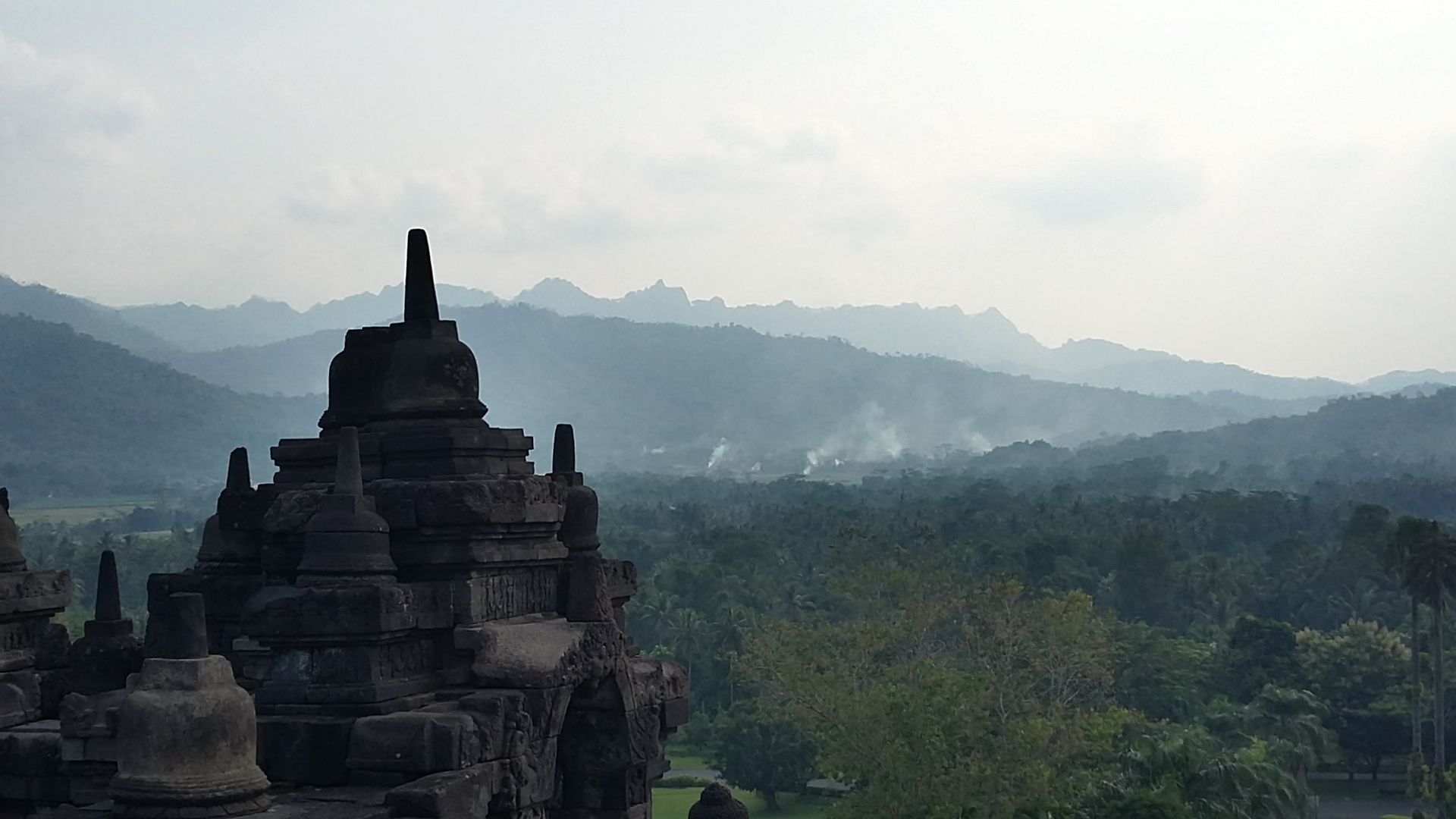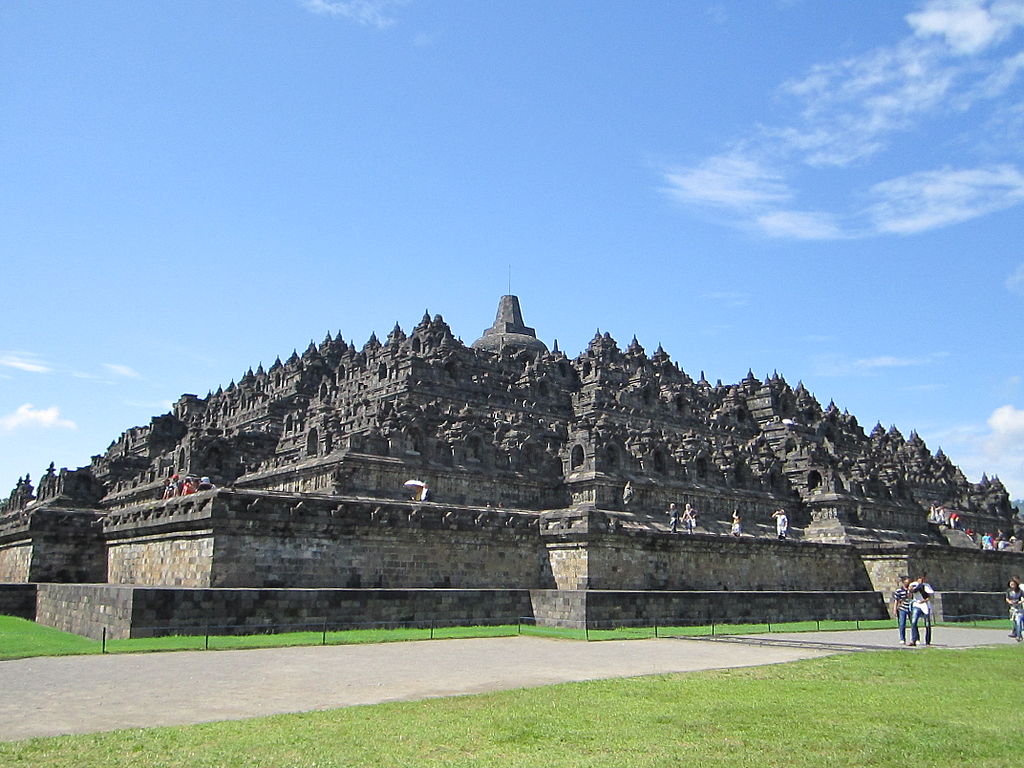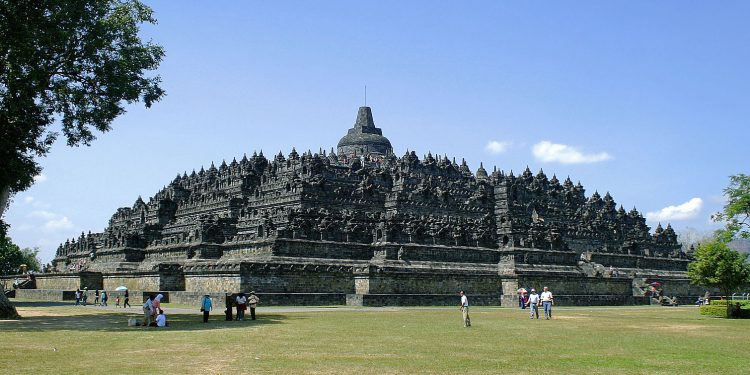Borobudur or Barabudur is a 9th-century Mahayana Buddhist Temple in Magelang, Central Java, Indonesia, as well as the world’s largest Buddhist temple, and also one of the greatest Buddhist monuments in the world. The temple consists of nine stacked platforms, six square and three circulars, topped by a central dome. The temple is decorated with 2,672 relief panels and 504 Buddha statues. The central dome is surrounded by 72 Buddha statues, each seated inside a perforated stupa
Shrine’s History
There is no written record of who built the Borobudur or of its intended purpose. The construction time has been estimated by comparison between carved reliefs on the temple’s hidden foot and the inscriptions commonly used in royal charters during the 8th and 9th centuries. Borobudur was likely founded around 800 CE. This corresponds to the period between 760 and 830 CE, the peak of the Sailendra dynasty rule of Mataram kingdom in central Java when it was under the influence of the Srivijayan Empire. The construction has been estimated to have taken 75 years and was completed during the reign of Samaratungga in 825.
There is confusion between Hindu and Buddhist rulers in Java around that time. The Sailendras were known as ardent followers of Buddhism, though stone inscriptions found at Sojomerto suggest they may have been Hindus. It was during this time that many Hindu and Buddhist monuments were built on the plains and mountains around the Kedu Plain. The Buddhist monuments, including Borobudur, were erected around the same period as the Hindu Shiva Prambanan temple compound. In 732 CE, the Shivaite King Sanjaya commissioned a Shivalinga sanctuary to be built on the Wukir hill, only 10 km east of Borobudur.
Construction of Buddhist temples, including Borobudur, at that time, was possible because of Sanjaya’s immediate successor, Rakai Panangkaran, granted his permission to the Buddhist followers to build such temples. In fact, to show his respect, Panangkaran gave the village of Kalasan to the Buddhist community, as is written in the Kalasan Charter dated 778 CE. This has led some archaeologists to believe that there was never serious conflict concerning religion in Java as it was possible for a Hindu king to patronise the establishment of a Buddhist monument; or for a Buddhist king to act likewise.
However, it is likely that there were two rival royal dynasties in Java at the time the Buddhist Sailendra and the Saivite Sanjaya?in which the latter triumphed over their rival in the 856 battle on the Ratubaka plateau. This confusion also exists regarding the Lara Jonggrang temple at the Prambanan complex, which was believed to have been erected by the victor Rakai Pikatan as the Sanjaya dynasty’s reply to Borobudur, but others suggest that there was a climate of peaceful coexistence where Sailendra involvement exists in Lara Jonggrang.


Architectural Relevance of This Shrine
Borobudur is built as a single large stupa and, when viewed from above, takes the form of a giant tantric Buddhist mandala, simultaneously representing the Buddhist cosmology and the nature of mind. The original foundation is a square, approximately 118 metres on each side. It has nine platforms, of which the lower six are square and the upper three are circular. The upper platform features seventy-two small stupas surrounding one large central stupa. Each stupa is bell-shaped and pierced by numerous decorative openings. Statues of the Buddha sit inside the pierced enclosures. The design of Borobudur took the form of a step pyramid. Previously, the prehistoric Austronesian megalithic culture in Indonesia had constructed several earth mounds and stone step pyramid structures called punden berundak as discovered in Pangguyangan site near Cisolok and in Cipari near Kuningan.
The construction of stone pyramids is based on native beliefs that mountains and high places are the abode of ancestral spirits or hyangs. The punden berundak step pyramid is the basic design in Borobudur, believed to be the continuation of older megalithic tradition incorporated with Mahayana Buddhist ideas and symbolism. The monument’s three divisions symbolize the three “realms” of Buddhist cosmology, namely Kamadhatu, Rupadhatu, and finally Arupadhatu. Ordinary sentient beings live out their lives on the lowest level, the realm of desire. Those who have burnt out all desire for continued existence leave the world of desire and live in the world on the level of form alone: they see forms but are not drawn to them. Finally, full Buddhas go beyond even form and experience reality at its purest, most fundamental level, the formless ocean of nirvana.
The liberation from the cycle of Samsara where the enlightened soul had no longer attached to worldly form corresponds to the concept of Sunyata, the complete voidness or the nonexistence of the self. Kamadhatu is represented by the base, Rupadhatu by the five square platforms, and Arupadhatu by the three circular platforms and the large topmost stupa. The architectural features between the three stages have metaphorical differences.
For instance, square and detailed decorations in the Rupadhatu disappear into plain circular platforms in the Arupadhatu to represent how the world of forms where men are still attached with forms and names changes into the world of the formless. Congregational worship in Borobudur is performed in a walking pilgrimage. Pilgrims are guided by the system of staircases and corridors ascending to the top platform. Each platform represents one stage of enlightenment. The path that guides pilgrims was designed to symbolize Buddhist cosmology.In 1885, a hidden structure under the base was accidentally discovered.The “hidden footing” contains reliefs, 160 of which are narratives describing the real Kamadhātu. The remaining reliefs are panels with short inscriptions that apparently provide instructions for the sculptors, illustrating the scenes to be carved.
The real base is hidden by an encasement base, the purpose of which remains a mystery. It was first thought that the real base had to be covered to prevent a disastrous subsidence of the monument into the hill.There is another theory that the encasement base was added because the originally hidden footing was incorrectly designed, according to Vastu Shastra, the Indian ancient book about architecture and town planning.Regardless of why it was commissioned, the encasement base was built with detailed and meticulous design and with aesthetic and religious consideration.






































